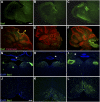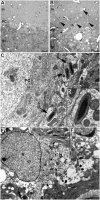Complex I deficiency due to loss of Ndufs4 in the brain results in progressive encephalopathy resembling Leigh syndrome
- PMID: 20534480
- PMCID: PMC2890717
- DOI: 10.1073/pnas.1006214107
Complex I deficiency due to loss of Ndufs4 in the brain results in progressive encephalopathy resembling Leigh syndrome
Abstract
To explore the lethal, ataxic phenotype of complex I deficiency in Ndufs4 knockout (KO) mice, we inactivated Ndufs4 selectively in neurons and glia (NesKO mice). NesKO mice manifested the same symptoms as KO mice including retarded growth, loss of motor ability, breathing abnormalities, and death by approximately 7 wk. Progressive neuronal deterioration and gliosis in specific brain areas corresponded to behavioral changes as the disease advanced, with early involvement of the olfactory bulb, cerebellum, and vestibular nuclei. Neurons, particularly in these brain regions, had aberrant mitochondrial morphology. Activation of caspase 8, but not caspase 9, in affected brain regions implicate the initiation of the extrinsic apoptotic pathway. Limited caspase 3 activation and the predominance of ultrastructural features of necrotic cell death suggest a switch from apoptosis to necrosis in affected neurons. These data suggest that dysfunctional complex I in specific brain regions results in progressive glial activation that promotes neuronal death that ultimately results in mortality.
Conflict of interest statement
The authors declare no conflict of interest.
Figures





Similar articles
-
Region-Specific Defects of Respiratory Capacities in the Ndufs4(KO) Mouse Brain.PLoS One. 2016 Jan 29;11(1):e0148219. doi: 10.1371/journal.pone.0148219. eCollection 2016. PLoS One. 2016. PMID: 26824698 Free PMC article.
-
Ndufs4 knockout mice with isolated complex I deficiency engage a futile adaptive brain response.Biochim Biophys Acta Proteins Proteom. 2025 Jan 1;1873(1):141055. doi: 10.1016/j.bbapap.2024.141055. Epub 2024 Oct 11. Biochim Biophys Acta Proteins Proteom. 2025. PMID: 39395749
-
Microglial response promotes neurodegeneration in the Ndufs4 KO mouse model of Leigh syndrome.Glia. 2022 Nov;70(11):2032-2044. doi: 10.1002/glia.24234. Epub 2022 Jun 30. Glia. 2022. PMID: 35770802 Free PMC article.
-
Ndufs4 knockout mouse models of Leigh syndrome: pathophysiology and intervention.Brain. 2022 Mar 29;145(1):45-63. doi: 10.1093/brain/awab426. Brain. 2022. PMID: 34849584 Free PMC article. Review.
-
Disease models of Leigh syndrome: From yeast to organoids.J Inherit Metab Dis. 2024 Nov;47(6):1292-1321. doi: 10.1002/jimd.12804. Epub 2024 Oct 9. J Inherit Metab Dis. 2024. PMID: 39385390 Free PMC article. Review.
Cited by
-
Feeding difficulties, a key feature of the Drosophila NDUFS4 mitochondrial disease model.Dis Model Mech. 2018 Mar 27;11(3):dmm032482. doi: 10.1242/dmm.032482. Dis Model Mech. 2018. PMID: 29590638 Free PMC article.
-
TREK-1 and TREK-2 Knockout Mice Are Not Resistant to Halothane or Isoflurane.Anesthesiology. 2023 Jul 1;139(1):63-76. doi: 10.1097/ALN.0000000000004577. Anesthesiology. 2023. PMID: 37027798 Free PMC article.
-
Hepatic S6K1 Partially Regulates Lifespan of Mice with Mitochondrial Complex I Deficiency.Front Genet. 2017 Sep 1;8:113. doi: 10.3389/fgene.2017.00113. eCollection 2017. Front Genet. 2017. PMID: 28919908 Free PMC article.
-
Potassium Leak Channels and Mitochondrial Complex I Interact in Glutamatergic Interneurons of the Mouse Spinal Cord.Anesthesiology. 2024 Apr 1;140(4):715-728. doi: 10.1097/ALN.0000000000004891. Anesthesiology. 2024. PMID: 38147628 Free PMC article.
-
Low doses of the neonicotinoid insecticide imidacloprid induce ROS triggering neurological and metabolic impairments in Drosophila.Proc Natl Acad Sci U S A. 2020 Oct 13;117(41):25840-25850. doi: 10.1073/pnas.2011828117. Epub 2020 Sep 28. Proc Natl Acad Sci U S A. 2020. PMID: 32989137 Free PMC article.
References
-
- Rahman S, et al. Leigh syndrome: Clinical features and biochemical and DNA abnormalities. Ann Neurol. 1996;39:343–351. - PubMed
-
- Munaro M, et al. A single cell complementation class is common to several cases of cytochrome c oxidase-defective Leigh's syndrome. Hum Mol Genet. 1997;6:221–228. - PubMed
-
- Piao YS, Tang GC, Yang H, Lu DH. Clinico-neuropathological study of a Chinese case of familial adult Leigh syndrome. Neuropathology. 2006;26:218–221. - PubMed
Publication types
MeSH terms
Substances
Grants and funding
LinkOut - more resources
Full Text Sources
Other Literature Sources
Molecular Biology Databases
Research Materials

